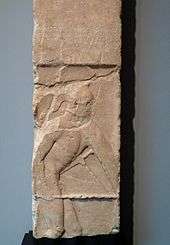Definify.com
Webster 1913 Edition
Stele
Webster 1828 Edition
Stele
STELE
,Noun.
Definition 2025
Stele
stele
stele
English
Pronunciation
Noun
stele (plural steles)
Etymology 2
From Ancient Greek στήλη (stḗlē, “upright rock; pillar; column”), plural form στῆλαι (stêlai).
Alternative forms
Pronunciation
Noun
stele (plural steles or stelai)
- (archaeology) An upright (or formerly upright) slab containing engraved or painted decorations or inscriptions; a stela.
- 1820, T. S. Hughes, Trav. Sicily, I x 303:
- A superior class of members...had their names inscribed upon a marble stélé or column.
- 1825, T. D. Fosbroke, Encycl. Antiq., I v 70:
- It appears, that when any one of the family died, a stelè to his memory was added to the tomb.
- 1847, J. Leitch translating C. O. Müller, Anc. Art, §224 193:
- In Egypt [obelisks] belonged to the class of steles (commemorative pillars).
- 1884, A. Lang, Custom & Myth, 285:
- The Australian stele, or grave-pillar.
- 1820, T. S. Hughes, Trav. Sicily, I x 303:
- (archaeology, uncommon) Any carved or engraved surface.
- 1877, A. B. Edwards, Thousand Miles up Nile, VI 143:
- Two large hieroglyphed steles incised upon the face of a projecting mass of boldly rounded cliff.
- 1877, A. B. Edwards, Thousand Miles up Nile, VI 143:
- (architecture, archaeology, obsolete) An acroterion, the decoration on the ridge of an ancient Greek building such as a temple.
- c. 1840, Hosking, "Architecture" in Encyclopædia Britannica, III 470:
- Stele. The ornaments on the ridge of a Greek temple, answering to the antefixæ on the summit of the flank entablatures, are thus designated.
- c. 1840, Hosking, "Architecture" in Encyclopædia Britannica, III 470:
Usage notes
- Although stela and stele were used in antiquity for pillars and columns generally, and continued to carry that meaning when their use was revived in English archaeology and architecture in the 18th and 19th century, respectively, present usage usually distinguishes obelisks, columns, shafts (the body of a column between the capital and the pediment), etc., from stela and stele, which are used to refer to engraved slabs or small pillars.
- Furthermore, although the terms still refer to small pillarlike gravestones from antiquity, the similar-looking herms are now often distinguished, as are modern gravestones, monuments, boundary markers, etc.
- The terms do sometimes refer to undecorated rocks when they have been raised by artificial means in prehistoric times, particularly when they are slab-like, but the large Neolithic menhirs are usually distinguished as are Chinese scholar's rocks or Taihu rocks, and other modern uses of upright stones as decoration or signage.
- Stele is frequently pluralized irregularly as stelae, but this is a hypercorrection arising from confusion with the Latin-derived stela. The anglicized Greek plural stelai has been used since the late 19th century but is less common than steles.
Synonyms
Derived terms
Translations
(archaeology) tall, slender stone monument
Etymology 3
From 1886 French stèle, from Ancient Greek στήλη (stḗlē, “upright rock; pillar; column”).
Noun
stele (plural steles)
- (botany) The central core of a plant's root and stem system, especially including the vascular tissue and developed from the plerome.
- 1895, Sydney Howard Vines, A Students' Text-book of Botany, 179:
- The stele may have—in different structures—one to many protoxylem (primitive wood) groups, and is accordingly described as monarch...diarch...triarch...tetrarch...polyarch.
- 1898, Hobart Charles Porter translating Eduard Strasburger & al. A Text-book of Botany, 109:
- The so-called central cylinder, for which Van Tieghem has proposed the name stele (column).
- 1895, Sydney Howard Vines, A Students' Text-book of Botany, 179:
Translations
(botany) central core of the root and shoot system
Anagrams
Italian
Pronunciation
- IPA(key): /ˈstɛ.le/
- Rhymes: -ɛle
- Hyphenation: stè‧le
Noun
stele f (invariable)
- stele (all senses)
Anagrams
Norwegian Bokmål
Etymology
From Ancient Greek στήλη (stḗlē, “pillar”).
Noun
stele m (definite singular stelen, indefinite plural steler, definite plural stelene)
- (archaeology) A tall, slender stone monument, often with writing carved into its surface
References
- “stele” in The Bokmål Dictionary.
Norwegian Nynorsk
Etymology 1
From Ancient Greek στήλη (stḗlē, “pillar”).
Noun
stele m (definite singular stelen, indefinite plural stelar, definite plural stelane)
- (archaeology) tall, slender stone monument, often with writing carved into its surface
Etymology 2
Verb
stele (present tense stel, past tense stal, past participle stole, passive infinitive stelast, present participle stelande, imperative stel)
- Alternative form of stela
Swedish
Adjective
stele
- absolute definite natural masculine form of stel.
References
- ↑ Oxford English Dictionary. "Stele".
